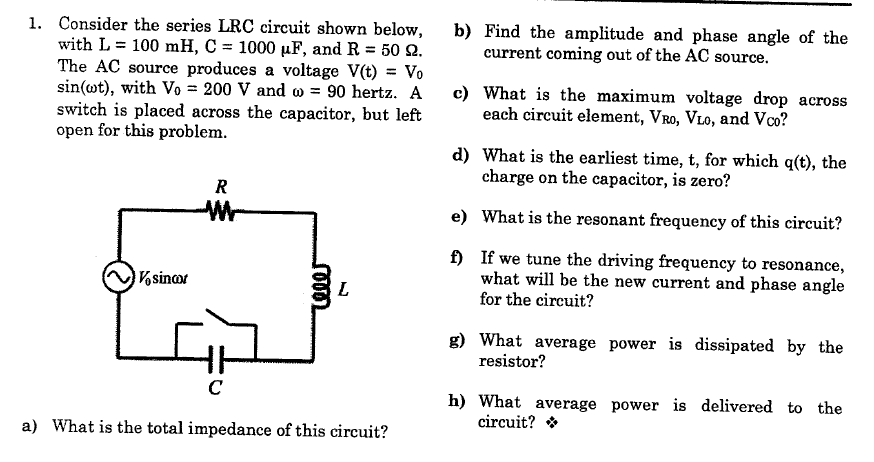What is the resonant frequency of this circuit? If we tune the driving frequency to resonance, what will be the new current and phase angle for the circuit? What average power is dissipated by the resistor? What average power is delivered to the circuit? *
What is the resonant frequency of this circuit? If we tune the driving frequency to resonance, what will be the new current and phase angle for the circuit? What average power is dissipated by the resistor? What average power is delivered to the circuit? *
Introductory Circuit Analysis (13th Edition)
13th Edition
ISBN:9780133923605
Author:Robert L. Boylestad
Publisher:Robert L. Boylestad
Chapter1: Introduction
Section: Chapter Questions
Problem 1P: Visit your local library (at school or home) and describe the extent to which it provides literature...
Related questions
Question
Please help efgh, thank you!

Transcribed Image Text:1. Consider the series LRC circuit shown below,
with L = 100 mH, C = 1000 µF, and R = 50 2.
The AC source produces a voltage V(t) = Vo
sin(ot), with Vo = 200 V and w = 90 hertz. A
switch is placed across the capacitor, but left
open for this problem.
b) Find the amplitude and phase angle of the
current coming out of the AC source.
c) What is the maximum voltage drop across
each circuit element, VRo, VLo, and Vco?
d) What is the earliest time, t, for which q(t), the
charge on the capacitor, is zero?
R
Wr-
e) What is the resonant frequency of this circuit?
f) If we tune the driving frequency to resonance,
what will be the new current and phase angle
for the circuit?
Vsinor
L
g) What average power is dissipated by the
resistor?
C
h) What average power is delivered to the
circuit? *
a) What is the total impedance of this circuit?
Expert Solution
This question has been solved!
Explore an expertly crafted, step-by-step solution for a thorough understanding of key concepts.
This is a popular solution!
Trending now
This is a popular solution!
Step by step
Solved in 5 steps

Knowledge Booster
Learn more about
Need a deep-dive on the concept behind this application? Look no further. Learn more about this topic, electrical-engineering and related others by exploring similar questions and additional content below.Recommended textbooks for you

Introductory Circuit Analysis (13th Edition)
Electrical Engineering
ISBN:
9780133923605
Author:
Robert L. Boylestad
Publisher:
PEARSON

Delmar's Standard Textbook Of Electricity
Electrical Engineering
ISBN:
9781337900348
Author:
Stephen L. Herman
Publisher:
Cengage Learning

Programmable Logic Controllers
Electrical Engineering
ISBN:
9780073373843
Author:
Frank D. Petruzella
Publisher:
McGraw-Hill Education

Introductory Circuit Analysis (13th Edition)
Electrical Engineering
ISBN:
9780133923605
Author:
Robert L. Boylestad
Publisher:
PEARSON

Delmar's Standard Textbook Of Electricity
Electrical Engineering
ISBN:
9781337900348
Author:
Stephen L. Herman
Publisher:
Cengage Learning

Programmable Logic Controllers
Electrical Engineering
ISBN:
9780073373843
Author:
Frank D. Petruzella
Publisher:
McGraw-Hill Education

Fundamentals of Electric Circuits
Electrical Engineering
ISBN:
9780078028229
Author:
Charles K Alexander, Matthew Sadiku
Publisher:
McGraw-Hill Education

Electric Circuits. (11th Edition)
Electrical Engineering
ISBN:
9780134746968
Author:
James W. Nilsson, Susan Riedel
Publisher:
PEARSON

Engineering Electromagnetics
Electrical Engineering
ISBN:
9780078028151
Author:
Hayt, William H. (william Hart), Jr, BUCK, John A.
Publisher:
Mcgraw-hill Education,